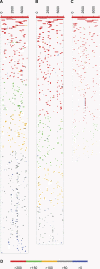RNA viral community in human feces: prevalence of plant pathogenic viruses
- PMID: 16336043
- PMCID: PMC1310650
- DOI: 10.1371/journal.pbio.0040003
RNA viral community in human feces: prevalence of plant pathogenic viruses
Abstract
The human gut is known to be a reservoir of a wide variety of microbes, including viruses. Many RNA viruses are known to be associated with gastroenteritis; however, the enteric RNA viral community present in healthy humans has not been described. Here, we present a comparative metagenomic analysis of the RNA viruses found in three fecal samples from two healthy human individuals. For this study, uncultured viruses were concentrated by tangential flow filtration, and viral RNA was extracted and cloned into shotgun viral cDNA libraries for sequencing analysis. The vast majority of the 36,769 viral sequences obtained were similar to plant pathogenic RNA viruses. The most abundant fecal virus in this study was pepper mild mottle virus (PMMV), which was found in high concentrations--up to 10(9) virions per gram of dry weight fecal matter. PMMV was also detected in 12 (66.7%) of 18 fecal samples collected from healthy individuals on two continents, indicating that this plant virus is prevalent in the human population. A number of pepper-based foods tested positive for PMMV, suggesting dietary origins for this virus. Intriguingly, the fecal PMMV was infectious to host plants, suggesting that humans might act as a vehicle for the dissemination of certain plant viruses.
Figures





References
-
- Backhed F, Ley RE, Sonnenburg JL, Peterson DA, Gordon JI. Host-bacterial mutualism in the human intestine. Science. 2005;307:1915–1920. - PubMed
-
- Nicholson JK, Holmes E, Wilson ID. Gut microorganisms, mammalian metabolism and personalized health care. Nat Rev Microbiol. 2005;3:431–438. - PubMed
-
- Weinbauer MG. Ecology of prokaryotic viruses. FEMS Microbiol Rev. 2004;28:127–181. - PubMed
Publication types
MeSH terms
Associated data
- Actions
- Actions
- Actions
LinkOut - more resources
Full Text Sources
Other Literature Sources
Medical
Molecular Biology Databases

